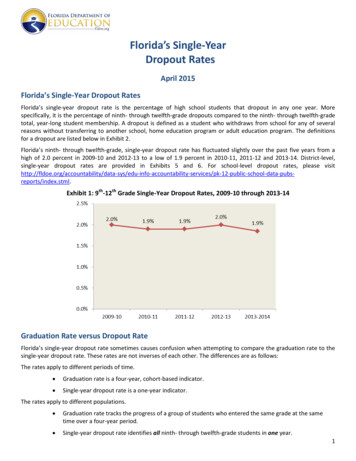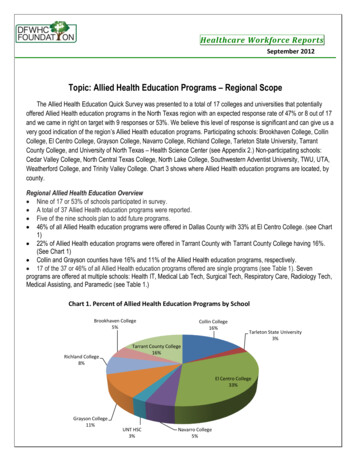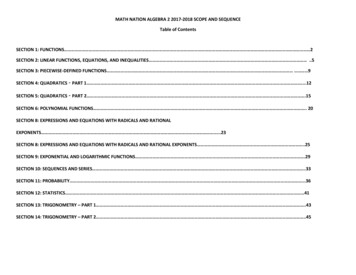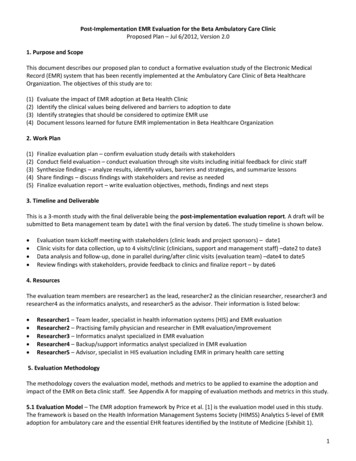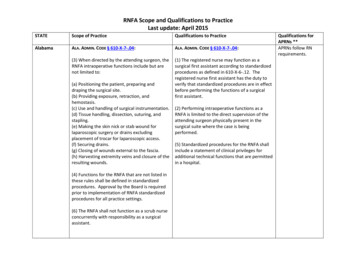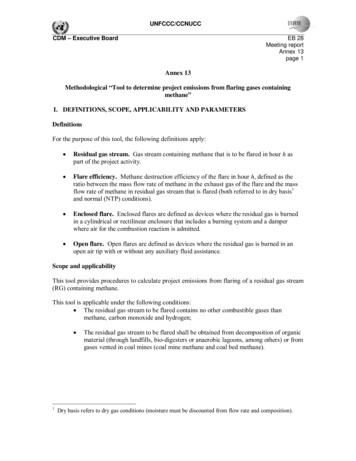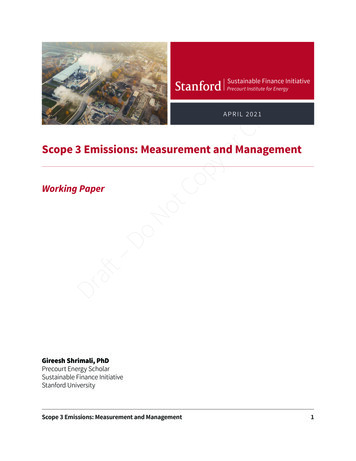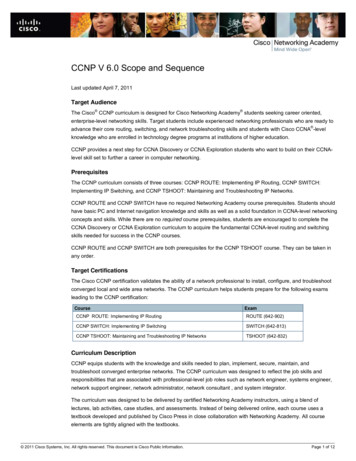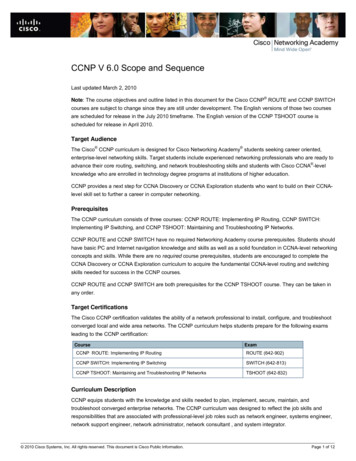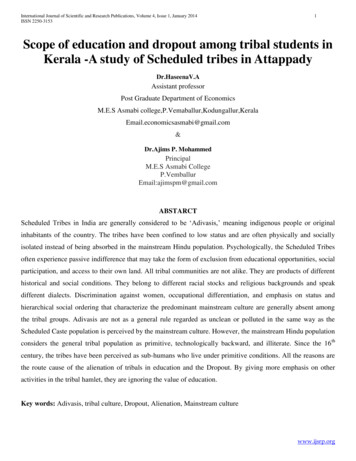
Transcription
International Journal of Scientific and Research Publications, Volume 4, Issue 1, January 2014ISSN 2250-31531Scope of education and dropout among tribal students inKerala -A study of Scheduled tribes in AttappadyDr.HaseenaV.AAssistant professorPost Graduate Department of EconomicsM.E.S Asmabi micsasmabi@gmail.com&Dr.Ajims P. MohammedPrincipalM.E.S Asmabi cheduled Tribes in India are generally considered to be ‘Adivasis,’ meaning indigenous people or originalinhabitants of the country. The tribes have been confined to low status and are often physically and sociallyisolated instead of being absorbed in the mainstream Hindu population. Psychologically, the Scheduled Tribesoften experience passive indifference that may take the form of exclusion from educational opportunities, socialparticipation, and access to their own land. All tribal communities are not alike. They are products of differenthistorical and social conditions. They belong to different racial stocks and religious backgrounds and speakdifferent dialects. Discrimination against women, occupational differentiation, and emphasis on status andhierarchical social ordering that characterize the predominant mainstream culture are generally absent amongthe tribal groups. Adivasis are not as a general rule regarded as unclean or polluted in the same way as theScheduled Caste population is perceived by the mainstream culture. However, the mainstream Hindu populationconsiders the general tribal population as primitive, technologically backward, and illiterate. Since the 16thcentury, the tribes have been perceived as sub-humans who live under primitive conditions. All the reasons arethe route cause of the alienation of tribals in education and the Dropout. By giving more emphasis on otheractivities in the tribal hamlet, they are ignoring the value of education.Key words: Adivasis, tribal culture, Dropout, Alienation, Mainstream culturewww.ijsrp.org
International Journal of Scientific and Research Publications, Volume 4, Issue 1, January 2014ISSN 2250-31532INTRODUCTIONIndia is homeland to a number of tribal communities with diverse eco-cultural, socio-economic and geographicalbackgrounds. According to the 2001 Census, Scheduled Tribes (notified by the Government of India under Article342 of the Indian Constitution) constitute 8.14% of the total population of the country, numbering 84.51 million. Inthe state of Kerala, 1% of the total population is tribal population, comprising of 36 unique Scheduled Tribes (ST)whose livelihoods are also varied: hunting-gathering, shifting cultivation, settled agriculture, contract labour, etc.,are some of them. According to the 2001 Census, the literacy rate of the Scheduled Tribes of India is only 47.10%.Against the National literacy rate of 65.8%, this is appalling. Even in the State of Kerala with a high literacy rate at90.92%, that of the Scheduled Tribes is far behind, at only 64.5%. Realizing that Scheduled Tribes are one of themost deprived and marginalized groups with respect to education, a host of programmes and measures have beeninitiated ever since independence of the country. Education of ST children is important not just due to aConstitutional obligation to equality of its citizen or special entitlements to ST, but because it is a crucial input in thenation‘s strategy of total development of tribal communities. However, despite nation‘s efforts to ensureconstitutional equality, dignity and development that they themselves wish for, the tribal people have lagged behindin education owing to external as well as internal constraints, socio-economic and cultural background of the tribalsand psychological problems of first generation learners etc.The Scheduled Tribe population represents one of the most economically impoverished and marginalizedgroups in India. Although Scheduled Tribes are a minority, they constitute about 8.2 % of the total population inIndia (Census of India, 2001), or 85 million people in absolute number. The Scheduled Tribes are notdiscriminated against in the same way by the mainstream Hindu population as the Scheduled Caste populationin India. While the latter group belongs to the lowest hierarchy of social order and is often considered impure orunclean, the Scheduled Tribes have, for the most part, been socially distanced and living outside the mainstreamHindu society. The areas inhabited by the tribal population constitute a significant part of the underdevelopedareas of the country. Scheduled Tribe population represents one of the most economically impoverished andmarginalized groups in India.Education is the most important instrument for human resource development and has a great significance. Onecannot imagine education without schools as it plays a major role in moulding the basic ideas, habits andattitudes of the children, with a view to producing well balanced individuals. Schools provide not onlyeducation to the children but also keep them away from the social evils. The main problem in schools is theproblem of stagnation and drop out phenomena. Education is the key that opens the door of life. It plays apivotal role in social change and it brings perfections in human life, an upward mobility in social status, radicaltransformation in outlook and perception. Education is widely accepted as the essential tool for the attainmentwww.ijsrp.org
International Journal of Scientific and Research Publications, Volume 4, Issue 1, January 2014ISSN 2250-31533of the developmental goals and leads to political consciousness, awareness of rights and duties among thepeople of a nation and it is the most important instrument for human resource development and has a greatsignificance in the context of developing countries.The Indian Constitution identifies and provides special consideration for certain ethnic minority groups,traditionally referred to as tribes or tribals, as Scheduled Tribes (STs) who constitute around 8 per cent of thetotal population of the country. There are 573 STs living in different parts of the country. Most of the tribalcommunities have their own languages and culture different from the language spoken in the state where theyare located. There are more than 270 such languages. Tribal communities in Kerala are scattered in differentdistricts. Of these the highest concentration is located in wayanad, Idukki and Attappady block of PlakkadDistrict. There are more than 37 tribal communities in kerala.Scheduled Tribes who have been historically out of the mainstream development initiatives partly due to thestill continuing socio-economic barriers and partly due to the inadequacy of the Government programmes inreaching these disadvantaged groups, still find themselves in difficult to compete with other sections of thesociety. Tribes are very important in constituting the population of the country as they are 8.2 percent of thetotal population of India. They constitute 3.2 percent of the total population of Kerala. Tribal education hasmany problems to face as hindrance for development. These are external constraints and internal constraints.External constrains: ST students constitutes 1.2 percent of the total enrollment in schools. The perspectiveadopted for educational development among tribal communities fails to adequately address the specificdisadvantages characterizing tribal population .For instance, the population and distance norms formed by thegovernment have not been beneficial to tribal locations because of their sparse population and sporadicresidential patterns. Thogh Kerakla’s performance compares well with those of other states. The disparitiesbetween the marginalized communities and other social groups in terms of quantitative and qualitativeindicators. The disparities increase at higher and higher levels of education, particularly in technical andprofessional education which provide better access to more remunerative jobs. It theses disparities within thestate that matter more in view of the high unemployment rate in the state and consequently the highlycompetitive nature of the labour market Further, in formulating policies and programmes for tribal education itis essential to understand the complex realities of tribal life and the expectation of tribals from the system, andthis has never been done either by the tribal welfare department or by the education department. Consequently,no worthwhile policy for tribal education has been formed. Because the more pass percentage rate from theschools of STs can only produces more students for higher education. Besides most of the increase inwww.ijsrp.org
International Journal of Scientific and Research Publications, Volume 4, Issue 1, January 2014ISSN 2250-31534employment in the country and the state is taking place in the private sector rather than in the public sector. Insuch a context job reservation for STs in the public sector become less relevant today in accessing jobs by them.Internal constraints: The internal problems of tribal education refer to the quality of school provision, suitableteachers, relevance of content and curriculum, medium of instruction, pedagogy, and special supervision. Amajority of schools in tribal areas are without basic infrastructure facilities. Normally, school buildings in tribalareas have thatched roofs, dilapidated walls, and non-plastered floors. Research evidence shows that a largenumber of tribal schools do not have teaching-learning materials, or even blackboards. In tribal areas theopening of a school is equated with the posting of a teacher and same is the case with 'ashram' schools. Thoughthe demand for changing the content and curriculum to suit the tribal context has been an old one, no seriouseffort has been made in this direction in any state, except for some sporadic pilot projects. The uniform structureand transaction of curriculum has put tribal children at a disadvantage. Apart from all this lack of awareness ofthe teachers about tribal culture and environment also force the tribal students to withdraw from education. Allthese issues are emerging in their primary and high school levels. These constraints force them to drop-out theireducation at very early levels and higher education will be only a dream for them.Review of LiteratureReview of related literature is pre-requisite to actual planning of any scientific research. It allows the researcherto acquaint himself with current knowledge in the field or area in which he is going to conduct his research.A comparison of the traditional and modern system and tribal higher education was made by NarmadeswerPrased (1991) who found that the tribe’s men desire an education which may enables them to fit in to themodern world. Most of the students are dropping their education because of lack of suitability of presenteducation with the tribal culture. The author suggested that the tribe’s men should concentrate more on skilledoccupations. Another important suggestion was for the setting up of special schools for them where adequateattention for them is ensured.Bairathi (1991) has examined the role of education for tribal upliftment has said that the condition of schoolparticularly in the interior parts of tribal settlements is worse. These are not well managed and there is shortageof teachers in most of the schools at all time. Primary level schools are managed by a single teacher. Theteacher has to take care of not only the management of school, but also to teach many classes simultaneously inone big room. In such a condition a good standard of education cannot be attained. Shortage of teachers, lack ofbasic amenities as sitting arrangements, drinking water facilities, and high distance from home to school leadsthem to loose the interest in education and this force them to drop their study. He made the suggestion forimproving the infrastructure facilities to improve the conditions of education and to remove Drop-out.www.ijsrp.org
International Journal of Scientific and Research Publications, Volume 4, Issue 1, January 2014ISSN 2250-31535Gadgil and Dandekar(1991) has studied about the problem of wastages in tribal education by taking a batch ofstudents in first standard in a given year following up in the subsequent years till the last grade are reached. i.e,fifth Drop-outs from school before completing the final grading of primary education constitutes wastes; andthe incidence of wastage is computed from the proportion of Drop-out to the initial enrolment in the first grade.He reached the conclusion that attention by the teacher to a great extent can remove drop out. When the studentsare continuing their education in a better perspective then only they can easily get accessability to highereducation.The National Council of educational Research and training made substantial contribution to the area oftribal education. A seminar on tribal education in India (1993) organized by the National council of educationalresearch and Training discussed the various aspects of tribal education like the facilities available, coverage,wastage and stagnation, utilization of financial assistance, basic problem of tribal education, socio-economicproblems, curriculum, methods and text books and the relative roles of Government and voluntary agencies inthe education of tribal people. The seminar altogether has suggested a new revised curriculum for tribaleducation. Familiarity in tribal language by the teachers also is essential for the improvement in tribaleducational attainment.The evaluation committee on the welfare of scheduled castes scheduled tribes and other backwardcommunities in their Report (1993), reviewed the different stages of tribal education in Kerala. Manysuggestions were put forward regarding pre-primary education, primary education, higher education welfare oftribal students, improvement of tribal schools, compulsory primary education, educa
International Journal of Scientific and Research Publications, Volume 4, Issue 1, January 2014 5 ISSN 2250-3153 www.ijsrp.org Gadgil and Dandekar(1991) has studied about the problem of wastages in tribal education by taking a batch of students in first standard in a given year following up in the subsequent years till the last grade are reached. i.e,File Size: 467KBPage Count: 13


